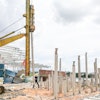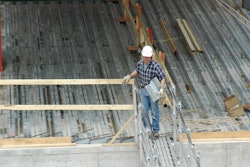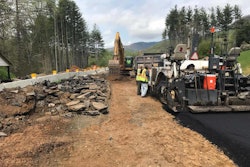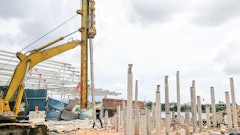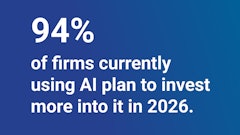
Here we are almost a year in to the new presidency and we are still waiting for the Trump Administration to unveil their $1T infrastructure investment that was initially slated as a 100-day campaign priority. While we’re patiently awaiting the plan and the details as to how it will be funded, we’ve gathered industry experts together to offer their insight on what 2018 might have in store for the road building industry.
Funding:
Q: Trump has promised a $1 trillion infrastructure plan, but we’ve seen that fall to the wayside. Do you think we will see a plan shake out in 2018? How will this be funded? Where should the money be allocated?
 Mike Acott, president, National Asphalt Pavement Association (NAPA)
Mike Acott, president, National Asphalt Pavement Association (NAPA)
A: Anirban Basu, chairman & CEO of Sage Policy Group Inc., an economic and policy consulting firm in Baltimore, MD: The proposed infrastructure plan represents our greatest and most commonsensical opportunity to accelerate U.S. economic growth. The plan would be largely financed by public-private partnerships designed to attract significant amounts of private capital, including U.S. multinational capital presently sitting abroad. Much of that offshore money cannot get back to America because it would have to pass through the filter of a 35 percent U.S. corporate tax rate and then also may be subject to state corporate taxes.
The solution is to offer significant tax advantages to multinationals reshoring financial capital by investing in public-private partnerships targeting infrastructure. These investment opportunities are likely to prove attractive because in many cases this infrastructure represents a monopoly.
For instance, municipal water systems are effectively monopolies. The same can be said for many wastewater treatment plants, toll roads and airports. These are regional monopolies and therefore can command rates that are sufficiently high to generate rates of return attractive to private investors.
Of course, there is a limit to this since the interests of ratepayers must also be considered. There are public policy considerations and some need to thread the needle. However, ratepayers are better off driving on safe bridges and drinking clean water than not. Government in many instances simply lacks the resources to fund the infrastructure needed to allow America to remain its preeminent position among global economies. There is, therefore, an opportunity to rebuild much of America’s infrastructure without layering on additional federal, state, and local government debt. Unfortunately, no real progress has been made in 2017 on this and 2018 prospects appear dubious given the growing imminence of mid-term elections.
A. Alison Premo Black, PhD, senior vice president & chief economist, deputy director contractors division at the American Road & Transportation Builders Association (ARTBA): There are still many details to be worked out about any type of infrastructure plan. Because of the timing, it is unlikely that a plan would have a large market impact in 2018. However, there are a number of regulatory reforms that either have been implemented (or are in the process) through executive orders, the Congressional Review Act and changes in rules and regulations. The easing of these regulations will help contractors.  Alison Premo Black, senior vice president & chief economist, Deputy Director Contractors Division, American Road & Transportation Builders (ARTBA)
Alison Premo Black, senior vice president & chief economist, Deputy Director Contractors Division, American Road & Transportation Builders (ARTBA)
A. Edward L. Mortimer, executive director, transportation & infrastructure, U.S. Chamber of Commerce: We believe there is strong support for the administration and Congress to address the nation’s infrastructure deficit after tax reform legislation is completed. The administration has stated their infrastructure package will include $200 billion in new investment and can be leveraged to provide up to a $1 trillion over 10 years. Details on how this will be allocated aren’t yet clear, but the Chamber believes any new investment should be based on projects that can provide the greatest economic return.
A. Darren Coughlin, 2017 Asphalt Recycling & Reclaiming Association's (ARRA) president: I am optimistic about the infrastructure plan for 2018. I believe it will be funded by various sources including; gas tax, user fees and private public partnerships. Funds should be allocated to rehabilitation needs of roads and structures that have a failing grade.
Q: How will the delay of the FAST Act increase impact 2018? What has been the impact on the asphalt road building industry under this highway bill so far? What have been the challenges with funding in 2017?
A. Basu: The Fixing America’s Surface Transportation Act, signed into law in December 2015, represents a major disappointment. The thinking was that this long-term federal highway bill would unleash more state and local government projects that depend upon predictable federal spending authorizations. That hasn’t happened because in too many instances what has been authorized has not been appropriated.
A number of states have in many instances handled these challenges by investing more of their own resources into roads, but this does not offset ongoing frustrations traceable to the federal government and the lack of money flowing from federal agencies to communities. Moreover, state resources are stretched by other priorities, including education, public safety, Medicaid, and shoring up underfunded pensions.
A. Acott: NAPA is not expecting any delays in highway lettings due to the short-term continuing resolution for the Fiscal Year 2018 transportation appropriations bill. Congress has routinely missed its budget deadlines, but has remained fully committed to the FAST Act funding levels. In general, the asphalt pavement industry has benefitted from states’ willingness to move projects forward thanks to the five years of certainty provided by the FAST Act. We have seen a steady increase in asphalt pavement tons nationally each year since the enactment of MAP-21.
States are certainly not waiting for Congress to boost highway investments. Since 2012, 31 states have approved gas tax increases or other plans to raise additional transportation revenue. More importantly, in states were legislators approved gas tax increases, nearly all the legislators who’ve faced voters after passing an increase won re-election.
A. Premo Black: It is always a challenge when states only receive part of their federal surface transportation funding. Some states may choose to delay projects until later in the year when they have access to their full annual funding levels.
The challenge with the FAST Act is that it provides funding levels that are just slightly above projected increases in inflation and project costs. While it provides stability, it is not significantly growing the market with increased investment. Therefore the funding dynamics at the state and local level become very important – states that have the ability to raise revenues, through legislative action, one time funding measures or variable rates, will be better off in the long run. Some states are still facing overall budget challenges and this often translates into less spending, fewer projects and even borrowing transportation-related revenues for general purposes.
A. Mortimer: We see minimal impact of Congress delaying the FAST Act funding increase in 2018. We are hopeful Congress will come to agreement on a full-year appropriations agreement by the current deadline.
A. Coughlin: Delaying FAST Act Increase could cause businesses to rethink or delay their capital expenditures moving forward. Our industry has seen positive growth since the FAST ACT has been implemented. States have adapted well to the FAST Act. For the most part states have complied with the requirements and are able to get the Federal Funding need to complete projects.
Q. Gas prices are at their lowest levels in years, is now the time to raise the federal gas tax to ensure long-term stability of the Highway Trust Fund? What has been the hesitation and why does Congress continue to “kick the can” down the road.
A. Acott: Now is the time for Congress to fix the structural deficit in the Highway Trust Fund. The Highway Trust Fund is expected to fall short of revenue in 2020. Congress needs to find a sustainable revenue source that increases investment for highways, roads, and bridges. A tax-reform bill is moving through Congress this fall, and NAPA’s top priority is to urge Congress to use that opportunity to fix the Highway Trust Fund funding problem. It is a once-in-a-generation chance that we cannot afford to let slip by.
Congress also needs to reauthorize the Federal Aviation Administration programs. Airfield pavements represent a $3 billion annual market for the asphalt pavement industry, and it is important for Congress to reauthorize this program in a timely fashion in 2018.
 Anirban Basu, chairman & CEO of Sage Policy Group Inc., an economic and policy consulting firm in Baltimore, MD
Anirban Basu, chairman & CEO of Sage Policy Group Inc., an economic and policy consulting firm in Baltimore, MD
A. Mortimer: We believe it is long past time to adjust the federal gasoline tax. Since the last time it was raised in 1993, it has lost over 40 percent of its purchasing power. During the same time period, 26 states have increased their gasoline user fee. The longer we wait to adjust the gasoline tax, the more the American taxpayer will end up paying, and our ability to compete in the global marketplace will diminish.
A. Coughlin: The Gas Tax is going to have to be part of the funding solution for long term stability of the Highway Trust Fund. Any Tax hike is not popular so Congress continues to campaign and not govern.
Q. While we have a long-term federal highway bill, what have been the challenges with state funding this year? How have states been handling these challenges?
Mortimer: States are looking for strong federal investment from a major infrastructure bill. We continue to see state and local government success in raising revenue for needed transportation investment. In the November 7, 2017 election, all eight ballot measures in five states were overwhelmingly approved. We also work to ensure all transportation programs receive full funding in the annual appropriations process. We also hope to address the upcoming shortfall in the Highway Trust Fund before the FAST Act expires in 2020.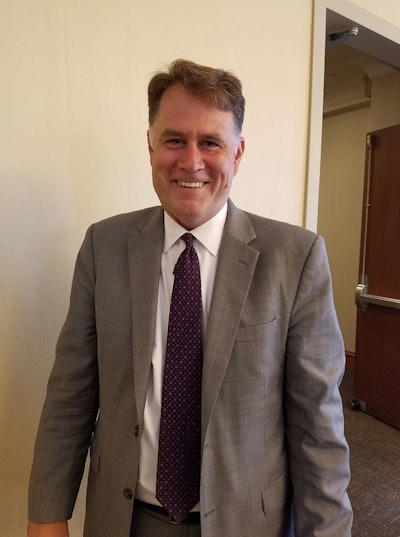 Edward L. Mortimer, executive director, transportation & infrastructure, U.S. Chamber of Commerce
Edward L. Mortimer, executive director, transportation & infrastructure, U.S. Chamber of Commerce
Q: What are some other ways we should be investigating to pay for our roads?
A. Premo Black: Public-Private Partnerships (P3s) are a viable method to finance transportation projects, but are not a way to fund transportation investment. States need a stable and growing source of revenue at the federal, state and loal level to make needed transportation investments. P3s are a great tool for certain projects that have a revenue stream, but are not a way to deliver a core program.
A. Acott: NAPA agrees that private sector capital and public–private partnerships can and should play an important role in any infrastructure plan. That role, however, must complement direct federal investment. While the private sector certainly has the ability to help advance projects — particularly those capable of generating a revenue stream — there is a difference between project financing and public funding. We must also acknowledge the private capital is not a viable option in many states, particularly those with large land areas and sparse populations.
The trucking industry like many stakeholder groups, such as the American Highway Users Alliance, understand that the bottlenecks and congestion freight traffic experiences has a negative impact on our country’s competitiveness. The FAST Act, for the first time, established and funded a freight program that directs funding specifically toward addressing this problem. While a good first start, Congress needs to provide more investment in developing and improving the freight highway network. In and of itself, the program does not provide the funding necessary to build out the FastLane corridors; however, it does serve a vital national interest and is one important reason why Congress should raise user fees. Interestingly, truckers support increasing diesel fuel taxes, if the revenue is directed to addressing freight congestion.
A. Mortimer: We believe P3s can be an important tool for project sponsors as they look to fund and finance infrastructure projects. Encouraging increased use of P3s can free up limited federal, state and local dollars for other infrastructure projects where a P3 does not make sense. Also, increased use of P3s are no replacement for increased federal investment.
2018 Outlook:
Q: Generally speaking, what will 2018 look like for asphalt highway contractors and producers?
A. Premo Black: The outlook for asphalt highway contractors and producers will continue to depend on the region or state where individual companies are operating. Based on recent trends in contract awards, we expect the market to stay fairly flat at the national level. However, we should start to see increased spending in states that have recently passed initiatives to increase revenues for transportation.
A. Acott: Right now, the economy is growing at a steady pace, which is helping the residential and commercial markets. We expect to see that trend continue into 2018 and, if Congress enacts tax reform legislation by the end of the year, it could accelerate. On the highway side, the FAST Act continues to ensure investment in the federal-aid highway program, and many states have approved user fee increases to support roadway construction and maintenance. In 2017 alone, seven states — California, Indiana, Montana, South Carolina, Oregon, Tennessee and West Virginia — have passed legislation to increase revenue from fuel sales. Contractors will see the benefit from these initiatives in 2018.
A. Couglin: In 2018, pavement preservation contractors will be focused on getting the word out on preserving and maintaining the assets that have already been bought and paid for. Through a combination of preservation and recycling disciplines. Through Everyday Counts (EDC4) the FHWA is focused on another two-year (2017-2018) initiative that centers on pavement preservation. Preserving assets and keeping them in good condition can save and stretch funds in the future.
 Darren Coughlin, 2017 Asphalt Recycling & Reclaiming Association's (ARRA) president
Darren Coughlin, 2017 Asphalt Recycling & Reclaiming Association's (ARRA) president
However, the realities of funding remain ever-present. In general, America continues to under-invest in infrastructure and 2018 will be no different. This represents the industry’s greatest challenge. Policymaking remains erratic, with policymakers frequently making the claim that America must invest more in infrastructure, and then underfunding infrastructure projects in their budgets. With the national debt now at $20 trillion and with Medicare set to become insolvent over the next decade, there will be many challenges going forward absent leaders who can unify us and get us to focus on what matters.
A. Mortimer: We believe that if the administration and Congress can come together on tax reform and an infrastructure bill, the economy can experience over 3.5 percent GDP growth. Along with continued regulatory relief, we believe 2018 could be the beginning of several years of sustained economic growth.
Q: What do you see as the greatest challenge impacting the road building industry as we move into 2018?
A. Mortimer: The greatest challenge to the road building industry is potential lack of certainty on tax and infrastructure policy. Without federal action on those two issues, states may delay major projects waiting to see if the federal government can provide some long-term certainty.
A. Premo Black: The biggest challenge to the industry, over the next 24 months, is the ability of Congress to find the political will and address the Highway Trust Fund. Federal investment accounts for about half of all state Department of Transportation highway and bridge capital outlays, including construction, right of way purchases and planning and design work.
A. Acott: Most contractors will tell you that recruiting and retaining top talent is an ongoing challenge. The retirement of Baby Boomers, competition from other industries, and adoption of new technologies have led to a shortage of workers in the construction industry. A focused effort by the industry will be necessary to meet this challenge.
Equally important is the issue of fixing the long-term solvency of the Highway Trust Fund. Highway funding will be impacted by 2020 if Congress does not make moves to shore up the Highway Trust Fund.
A. Coughlin: While 2018 will be strong with many opportunities for growth, the industry needs to combat the skilled labor challenge with more vocational education or the cost of those skilled workers will increase.



